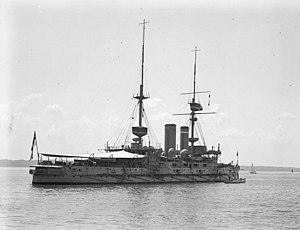 HMS Implacable at Spithead in 1909.
| |
| Class overview | |
|---|---|
| Name | Formidable-class battleship |
| Operators | |
| Preceded by | Canopus class |
| Succeeded by | London class |
| Built | 1898–1901 |
| In commission | 1901–1919 |
| Completed | 3 |
| Lost | 2 |
| Retired | 1 |
| General characteristics | |
| Class and type | Pre-dreadnought battleship |
| Displacement | |
| Length | 431 ft 9 in (131.6 m) o/a |
| Beam | 75 ft (22.9 m) |
| Draught |
|
| Installed power |
|
| Propulsion | |
| Speed | 18 knots (33 km/h; 21 mph) |
| Range | 5,100 nmi (9,400 km; 5,900 mi) at 10 knots (19 km/h; 12 mph) |
| Complement | 788 |
| Armament |
|
| Armour | |
The Formidable class of battleships were a three-ship class of pre-dreadnoughts designed by Sir William White and built for the Royal Navy in the late 1890s. The class comprised Formidable, Irresistible, and Implacable. They were armed with a battery of four 12-inch (305 mm) guns, they had top speed of 18 knots (33 km/h; 21 mph), and they marked the adoption of Krupp armour in British battleship designs. The class formed the basis for the nearly identical London class of five ships, and those ships are sometimes included in the Formidable class. Formidable, Irresistible, and Implacable were built between 1898 and 1901 at the Portsmouth, Chatham, and Devonport Dockyards, respectively.
All three ships served in the Mediterranean Fleet early in their careers, before returning to British waters in the late 1900s for duty in the Home Fleet, Channel Fleet, and the Atlantic Fleet. By 1912, all three ships had been assigned to the 5th Battle Squadron, Home Fleet, where they remained until the outbreak of the First World War in August 1914. They patrolled the English Channel in the early months of the war and escorted troopships carrying elements of the British Expeditionary Force and other British Army units across the Channel to France. On the night of 31 December 1914 – 1 January 1915 while on patrol in the Channel, the 5th Squadron encountered a German U-boat that torpedoed and sank Formidable. Irresistible was sent to the Dardanelles Campaign in February 1915, and after engaging in a series of attacks on the Ottoman coastal fortifications, she struck a naval mine and sank.
Implacable, the sole surviving member of the class, joined the Dardanelles operations in March 1915 and saw action during the landings at Cape Helles in April. She was later withdrawn, first in May 1915 to reinforce the Italian fleet guarding the Adriatic Sea and then to Salonika in November that year. After being recalled to Britain in July 1917, she was converted into a depot ship and used to support the Northern Patrol. After the war, she was sold for scrap in 1921 and was broken up in 1922.